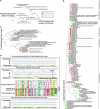High-throughput single-cell sequencing identifies photoheterotrophs and chemoautotrophs in freshwater bacterioplankton
- PMID: 21716306
- PMCID: PMC3246240
- DOI: 10.1038/ismej.2011.84
High-throughput single-cell sequencing identifies photoheterotrophs and chemoautotrophs in freshwater bacterioplankton
Abstract
Recent discoveries suggest that photoheterotrophs (rhodopsin-containing bacteria (RBs) and aerobic anoxygenic phototrophs (AAPs)) and chemoautotrophs may be significant for marine and freshwater ecosystem productivity. However, their abundance and taxonomic identities remain largely unknown. We used a combination of single-cell and metagenomic DNA sequencing to study the predominant photoheterotrophs and chemoautotrophs inhabiting the euphotic zone of temperate, physicochemically diverse freshwater lakes. Multi-locus sequencing of 712 single amplified genomes, generated by fluorescence-activated cell sorting and whole genome multiple displacement amplification, showed that most of the cosmopolitan freshwater clusters contain photoheterotrophs. These comprised at least 10-23% of bacterioplankton, and RBs were the dominant fraction. Our data demonstrate that Actinobacteria, including clusters acI, Luna and acSTL, are the predominant freshwater RBs. We significantly broaden the known taxonomic range of freshwater RBs, to include Alpha-, Beta-, Gamma- and Deltaproteobacteria, Verrucomicrobia and Sphingobacteria. By sequencing single cells, we found evidence for inter-phyla horizontal gene transfer and recombination of rhodopsin genes and identified specific taxonomic groups involved in these evolutionary processes. Our data suggest that members of the ubiquitous betaproteobacteria Polynucleobacter spp. are the dominant AAPs in temperate freshwater lakes. Furthermore, the RuBisCO (ribulose 1,5-bisphosphate carboxylase/oxygenase) gene was found in several single cells of Betaproteobacteria, Bacteroidetes and Gammaproteobacteria, suggesting that chemoautotrophs may be more prevalent among aerobic bacterioplankton than previously thought. This study demonstrates the power of single-cell DNA sequencing addressing previously unresolved questions about the metabolic potential and evolutionary histories of uncultured microorganisms, which dominate most natural environments.
Figures




Similar articles
-
Comparative 16S rRNA analysis of lake bacterioplankton reveals globally distributed phylogenetic clusters including an abundant group of actinobacteria.Appl Environ Microbiol. 2000 Nov;66(11):5053-65. doi: 10.1128/AEM.66.11.5053-5065.2000. Appl Environ Microbiol. 2000. PMID: 11055963 Free PMC article.
-
Metagenomic profiling of the microbial freshwater communities in two Bulgarian reservoirs.J Basic Microbiol. 2017 Aug;57(8):669-679. doi: 10.1002/jobm.201700137. Epub 2017 May 22. J Basic Microbiol. 2017. PMID: 28543439
-
Dilution-to-extinction culturing of psychrotolerant planktonic bacteria from permanently ice-covered lakes in the McMurdo Dry Valleys, Antarctica.Microb Ecol. 2008 Apr;55(3):395-405. doi: 10.1007/s00248-007-9284-4. Epub 2007 Jul 11. Microb Ecol. 2008. PMID: 17623231
-
Representative freshwater bacterioplankton isolated from Crater Lake, Oregon.Appl Environ Microbiol. 2004 Nov;70(11):6542-50. doi: 10.1128/AEM.70.11.6542-6550.2004. Appl Environ Microbiol. 2004. PMID: 15528517 Free PMC article.
-
A Metagenomic and Amplicon Sequencing Combined Approach Reveals the Best Primers to Study Marine Aerobic Anoxygenic Phototrophs.Microb Ecol. 2023 Oct;86(3):2161-2172. doi: 10.1007/s00248-023-02220-y. Epub 2023 May 6. Microb Ecol. 2023. PMID: 37148309 Free PMC article. Review.
Cited by
-
Whole-Genome Sequences of an Aerobic Anoxygenic Phototroph, Blastomonas sp. Strain AAP53, Isolated from a Freshwater Desert Lake in Inner Mongolia, China.Genome Announc. 2013 Mar 14;1(2):e0007113. doi: 10.1128/genomeA.00071-13. Genome Announc. 2013. PMID: 23516202 Free PMC article.
-
Marine Bacterial and Archaeal Ion-Pumping Rhodopsins: Genetic Diversity, Physiology, and Ecology.Microbiol Mol Biol Rev. 2016 Sep 14;80(4):929-54. doi: 10.1128/MMBR.00003-16. Print 2016 Dec. Microbiol Mol Biol Rev. 2016. PMID: 27630250 Free PMC article. Review.
-
Insights into variability of actinorhodopsin genes of the LG1 cluster in two different freshwater habitats.PLoS One. 2013 Jul 2;8(7):e68542. doi: 10.1371/journal.pone.0068542. Print 2013. PLoS One. 2013. PMID: 23844219 Free PMC article.
-
Productivity and salinity structuring of the microplankton revealed by comparative freshwater metagenomics.Environ Microbiol. 2014 Sep;16(9):2682-98. doi: 10.1111/1462-2920.12301. Epub 2013 Nov 12. Environ Microbiol. 2014. PMID: 24118837 Free PMC article.
-
Comparative metagenomics reveals impact of contaminants on groundwater microbiomes.Front Microbiol. 2015 Oct 31;6:1205. doi: 10.3389/fmicb.2015.01205. eCollection 2015. Front Microbiol. 2015. PMID: 26583008 Free PMC article.
References
-
- Atamna-Ismaeel N, Sabehi G, Sharon I, Witzel K-P, Labrenz M, Jurgens K, et al. Widespread distribution of proteorhodopsins in freshwater and brackish ecosystems. ISME J. 2008;2:656–662. - PubMed
-
- Beja O, Suzuki MT, Heidelberg JF, Nelson WC, Preston CM, Hamada T, et al. Unsuspected diversity among marine aerobic anoxygenic phototrophs. Nature. 2002;415:630–633. - PubMed
Publication types
MeSH terms
Substances
LinkOut - more resources
Full Text Sources
Molecular Biology Databases
Miscellaneous

